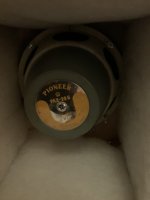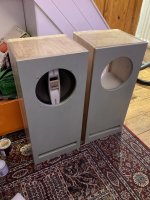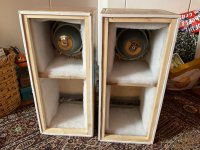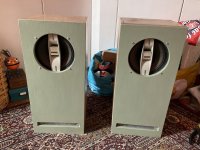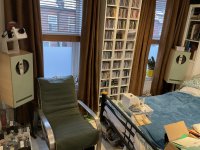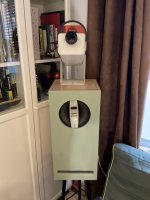We are approaching listening time! 
I didn't expect to see absorbent on the open bracing shelf - perhaps that's an area for experimentation.
Consider extending the bracing shelf rearwards using softwood strip so that it will contact the removable enclosure back.
The back can then be screwed to the extended bracing shelf as well as around the periphery of the enclosure, providing maximum vibration resistance.

I didn't expect to see absorbent on the open bracing shelf - perhaps that's an area for experimentation.
Consider extending the bracing shelf rearwards using softwood strip so that it will contact the removable enclosure back.
The back can then be screwed to the extended bracing shelf as well as around the periphery of the enclosure, providing maximum vibration resistance.
Last edited:
Yes not too far off…..I can remove the wadding from the shelf if you think it shouldn’t be there? I had read somewhere it could reduced any midrange frequencies coming out of the port but that could be completely 😑 Likewise I can fairly easily extend the bracing shelf to meet the back, the reason it’s slightly off is the bracing shelves were the original 15mm top and bottom pieces I stupidly cut slightly too small then ran out of 15mm ply and re cut the top an bottoms from scrap 12mm I had in the shed. The top seams on one cab have some annoying gaps which I intend to fill externally with sawdust mixed with alphiatic resin…perils of hand cuts with a circular saw. It won’t leak anyway as I sealed all the internal box seams with a bead of silicone….just in case! I’ve ordered some wool felt to experiment with but due to all the postal strikes it hasn’t arrived ☹️ I’m gonna try to get these finished tomorrow as I’m away over Christmas.We are approaching listening time!
I didn't expect to see absorbent on the open bracing shelf - perhaps that's an area for experimentation.
Consider extending the bracing shelf rearwards using softwood strip so that it will contact the removable enclosure back.
The removable back can then be screwed to the extended bracing shelf as well as around the periphery of the enclosure, providing maximum vibration resistance.
The polyester absorbent on your open shelf is unlikely to make much of an audible difference.
Briggs' acoustic filter consisted of several 1/16" slits in a plywood partition which only allowed bass frequencies to pass into the lower section of the enclosure - which then did not require to be lined with absorbent. This is the arrangement that reduced the transmission of sound through the vent at medium and high frequencies.
The main function of the acoustic filter was to reduce low frequency cone excursions and increase power handing when used with drivers having porous cloth or foam plastic surrounds. The acoustic filter was not suitable for drivers with airtight surrounds, for which an open bracing shelf was recommended.
Yes, let's get some listening done before Christmas! Any further tweaking can wait till 2023!
Any further tweaking can wait till 2023!
Briggs' acoustic filter consisted of several 1/16" slits in a plywood partition which only allowed bass frequencies to pass into the lower section of the enclosure - which then did not require to be lined with absorbent. This is the arrangement that reduced the transmission of sound through the vent at medium and high frequencies.
The main function of the acoustic filter was to reduce low frequency cone excursions and increase power handing when used with drivers having porous cloth or foam plastic surrounds. The acoustic filter was not suitable for drivers with airtight surrounds, for which an open bracing shelf was recommended.
Yes, let's get some listening done before Christmas!
 Any further tweaking can wait till 2023!
Any further tweaking can wait till 2023!Duly noted I’ll slap em together tomorrow and report back……😀The polyester absorbent on your open shelf is unlikely to make much of an audible difference.
Briggs' acoustic filter consisted of several 1/16" slits in a plywood partition which only allowed bass frequencies to pass into the lower section of the enclosure - which then did not require to be lined with absorbent. This is the arrangement that reduced the transmission of sound through the vent at medium and high frequencies.
The main function of the acoustic filter was to reduce low frequency cone excursions and increase power handing when used with drivers having porous cloth or foam plastic surrounds. The acoustic filter was not suitable for drivers with airtight surrounds, for which an open bracing shelf was recommended.
Yes, let's get some listening done before Christmas!Any further tweaking can wait till 2023!
I do hope these sound reasonable after all the effort.
Fingers crossed!
Happily, there is scope for tweaking the vent.
Fingers crossed!

Happily, there is scope for tweaking the vent.
Have faith Galu!😀 they are now up and running and to me sound really good. I’m biased cos I built em 🤔😉so take that with a pinch of salt but They really are much nicer sounding than I was expecting. At the mo I’m driving them with an overhauled quad 303 and a temperamental 33 but the aim is to use em to recommission some of my valve gear (some of which only have 15 ohm outputs) . I’ve just run a few cds I’m familiar with through em, including Fairports Liege and Lief and Harlem sessions (early 70’s blaxploitation era) which definitely has tracks with a lot of bass and they sound sweet. I can’t honestly say I’m noticing any annoying resonances and straight off the bat the sound seems balanced. When you stick your hand on a port it doesn’t feel like there is a ton of air moving (you can feel some movement) but they don’t sound bass light and it sounds tuneful. The drivers are probably still waking up as they’ve been carefully boxed in my loft for years now. Fortunately they seem to be working perfectly with no rubbing. I need to spend some time running different genres through them and am not desperate to start changing them on the basis of the first listen but if you have any thoughts re experimenting with tuning let me know. Thanks for your encouragement with this project, like most things it took more effort than I was anticipating! Pics in situ.I do hope these sound reasonable after all the effort.
Fingers crossed!
Happily, there is scope for tweaking the vent.
Regards
Mike
Attachments
That's a great result Mike!
I wouldn't expect to feel much air movement from those vents.
It doesn't sound as if you need to 'fine tune' the vents. Remember they are meant to provide 'broad tuning' in order to accommodate differences in driver resonance frequency.
If you do get the urge to experiment you can always try the effect of some reversible changes:

I wouldn't expect to feel much air movement from those vents.
It doesn't sound as if you need to 'fine tune' the vents. Remember they are meant to provide 'broad tuning' in order to accommodate differences in driver resonance frequency.
If you do get the urge to experiment you can always try the effect of some reversible changes:
- Covering the vent internally with your wool felt to form a resistive vent.
- Covering the vent completely with plywood to form a sealed enclosure.
- Plugging the vent partially to make incremental changes to its length and so alter the 'tuning'.

- Home
- Loudspeakers
- Full Range
- A blast from the past …Wharfedale 1cu ft cabinets

